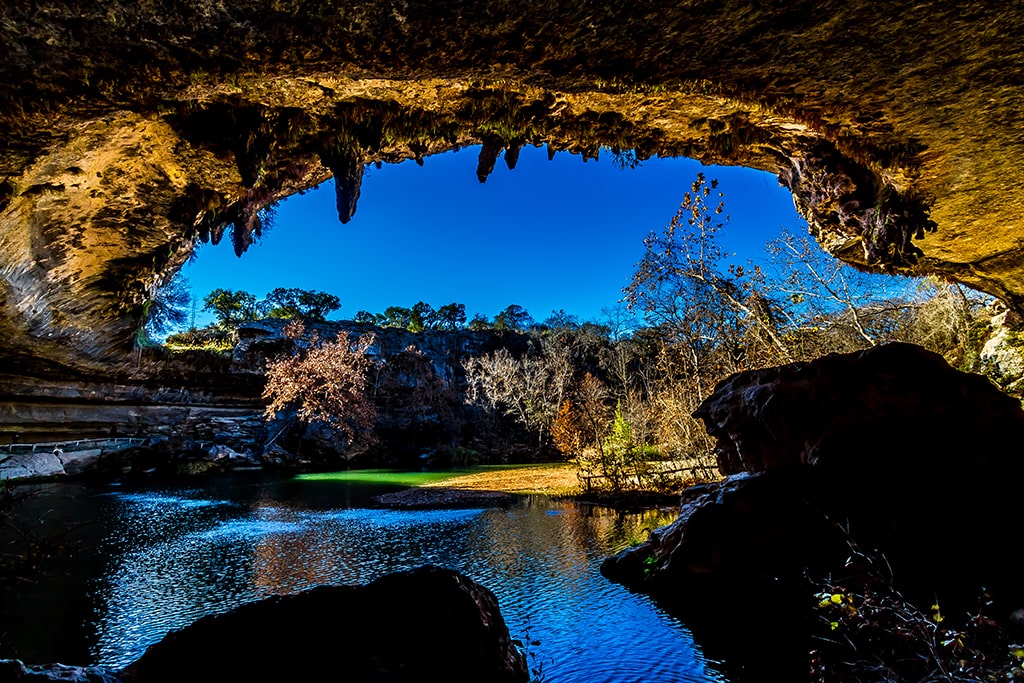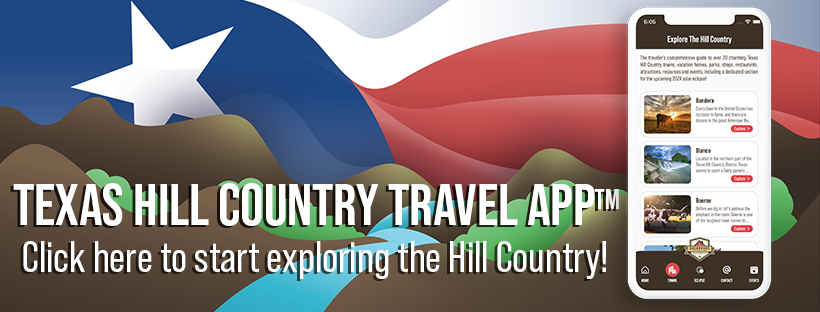
About 20 miles due west of Austin on Highway 290 you’ll find the peaceful town of Dripping Springs. The Texas Hill Country opens up here, in contrast to the big-city environs of the state capital, so the smaller town has earned the nickname “Gateway to the Hill Country.” Let’s take a look at their history, almost as old as the state of Texas itself.
To be clear, human habitation in the region itself goes back much longer than that, of course, with human remains and artifacts discovered in the area dating back 10,000 years or so. With the fortification of what we now call the Edwards Aquifer and nearby flowing bodies like the Pedernales River and Onion Creek, the region was (and still is) rich with farming and ranching land and abundant wildlife. As a result, over those centuries Native Americans, Spanish conquistadors and wanderers, Mexicans, and eventually white settlers gravitated toward what would become Dripping Springs.
Texas became a state in 1845, and it wasn’t long after that the roots of the future town would take hold. In the fall of 1853, three families known locally as the “Old Three” made their way westward from Mississippi; these were the families of Dr. Joseph Pound, John Moss, and John Wallace. (Besides being a founding father of Dripping Springs, Wallace would have another link to American fame; his uncle was future Confederate General Robert E. Lee.) Once in Texas and past Austin, the group headed west on the trail toward the Army fort at Fredericksburg, on roughly the path covered by Highway 290 today.
They didn’t make it all the way to Fredericksburg, though; 55 miles east of that target they came upon lofty Wallace Mountain and decided it would be an ideal place to settle and grow a new community. The house built by Dr. Pound in 1854 still stands, and is today home to the Dr. Pound Pioneer Farmstead Historical Museum, colloquially known as the “Pound House.”
John Moss was designated the town’s first postmaster in 1857, but they needed a name. His wife Nannie loved the limestone ledges that overlooked the nearby Pedernales River, and the soothing sound they made when water cascaded over the cliff faces. The sight inspired a name, and the town officially became Dripping Springs.
The first two decades of its existence, the town prospered and slowly but surely grew. Indian raids were a troublesome concern at the beginning, but these were under control by the early 1870s. More homes were built, and businesses cropped up, though there was no defined layout for the new town. It resembled a scattered clump of farmsteads more than an actual town at the start.
This was remedied in 1881 when businessman W.T. Chapman platted out a tidy and organized 12-block plan for Dripping Springs, giving it more definition. This kicked off a period of robust growth, and several businesses grew, including stores, a hotel, blacksmith shops, and a stagecoach terminal. A school and a number of churches found permanent homes there, too. Interestingly enough, even with a population of about 4,600 people today, Dripping Springs still has a rural and relaxed atmosphere.
That lasted a good 100 years, and the locals felt no pressing need to incorporate. That changed in the early 1980s when the city of Austin drew up plans to annex unincorporated land to the west and northwest of the city. Dripping Springs (among several other communities) was motivated to officially incorporate in 1981; this gave them autonomy and the ability to self-govern.
With its beginnings as a farming and ranching community, Dripping Springs has grown into a Hill Country tourism hub, and in recent years has earned a new distinction. In partnership with Dark Sky International, a nonprofit agency devoted to reducing light pollution and making night skies friendlier to astronomers, Dripping Springs became the first officially designated Dark Sky Community in Texas in 2014. This has targeted the town as a great place to stargaze!
No matter what draws you to Dripping Springs, we’d like to help maximize your visit! We’ve researched businesses and attractions in this awesome town, and that info is ready for you at the bottom of this page in listings sorted by category. All the shops, parks, restaurants, and kid-friendly spots in and around Dripping Springs are just a click or two away. It’s a great road map for your visit!
If you’d like to take a look at other towns in the Hill Country, we’ve thought of that, too! We’ve put dream vacations together in the area (we live and work here, and we love it), and all the expertise we’ve gathered since 2001 is yours with a FREE download of the Texas Hill Country Travel App! We’ve researched over 1,800 local businesses and attractions, and it’s all in the app, sorted by town and type.
In over 20 years as Hill Country property management professionals, we’ve learned from our neighbors, business people, vacation rental owners, and travelers! Our app takes that knowledge and applies it to your unique vacation needs, from property listings to booking info, from check-in to heading home, and app-exclusive perks! We’ll even keep you up-to-date on special events in the area.
This beautiful region of the Lone Star State is our home, and we love showing it off! We’ve arranged Hill Country getaways for everything from romantic escapes to gatherings like weddings and reunions. Feel free to contact us; we’d love to inspire you to fall in love with the Texas Hill Country just as we have.
Discover the magic of Texas Hill Country with our Facebook Group! Whether you’ve booked a stay with Backroads Reservations, are planning your next getaway, or simply love this scenic region, our community is for you. Connect with fellow fans and celebrate the stunning beauty of the Hill Country!
Explore the Hill Country
The Backroads Reservations Hill Country Travel App

Antiques

Museums

Restaurants

Bars

Horseback Riding

Kid Friendly

Wineries

Gifts

Parks

Stores





